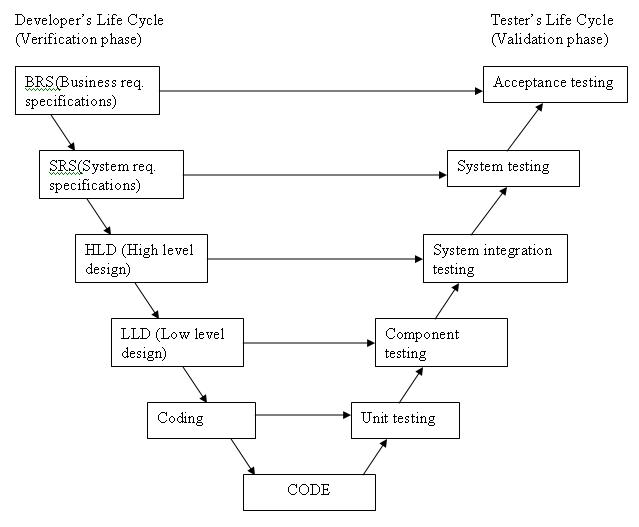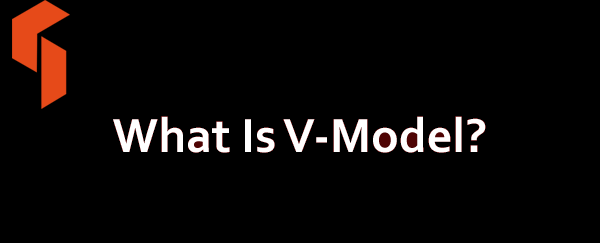V- model means Verification and Validation model. Just like the waterfall model, the V-Shaped life cycle is a sequential path of execution of processes. Each phase must be completed before the next phase begins. V-Model is one of the many software development models.
Testing of the product is planned in parallel with a corresponding phase of development in V-model.
Diagram of V-model:

The various phases of the V-model are as follows:
Requirements like BRS and SRS begin the life cycle model just like the waterfall model. But, in this model before development is started, a system test plan is created. The test plan focuses on meeting the functionality specified in the requirements gathering.
 The high-level design (HLD) phase focuses on system architecture and design. It provide overview of solution, platform, system, product and service/process. An integration test plan is created in this phase as well in order to test the pieces of the software systems ability to work together.
The high-level design (HLD) phase focuses on system architecture and design. It provide overview of solution, platform, system, product and service/process. An integration test plan is created in this phase as well in order to test the pieces of the software systems ability to work together.
The low-level design (LLD) phase is where the actual software components are designed. It defines the actual logic for each and every component of the system. Class diagram with all the methods and relation between classes comes under LLD. Component tests are created in this phase as well.
The implementation phase is, again, where all coding takes place. Once coding is complete, the path of execution continues up the right side of the V where the test plans developed earlier are now put to use.
Coding: This is at the bottom of the V-Shape model. Module design is converted into code by developers. Unit Testing is performed by the developers on the code written by them.
Advantages of V-model:
- Simple and easy to use.
- Testing activities like planning, test designing happens well before coding. This saves a lot of time. Hence higher chance of success over the waterfall model.
- Proactive defect tracking – that is defects are found at early stage.
- Avoids the downward flow of the defects.
- Works well for small projects where requirements are easily understood.
Disadvantages of V-model:
- Very rigid and least flexible.
- Software is developed during the implementation phase, so no early prototypes of the software are produced.
- If any changes happen in midway, then the test documents along with requirement documents has to be updated.
When to use the V-model:
- The V-shaped model should be used for small to medium sized projects where requirements are clearly defined and fixed.
- The V-Shaped model should be chosen when ample technical resources are available with needed technical expertise.
High confidence of customer is required for choosing the V-Shaped model approach. Since, no prototypes are produced, there is a very high risk involved in meeting customer expectations.
Other models to study:
- Waterfall model
- Incremental model
- RAD model
- Agile model
- Iterative model
- Spiral model
- Prototype model
Other popular articles:
- What are the Software Development Life Cycle (SDLC) phases?
- What are the Software Development Models?
- What is Iterative model- advantages, disadvantages and when to use it?
- What is Spiral model- advantages, disadvantages and when to use it?
- What is Incremental model- advantages, disadvantages and when to use it?
pia says
SIT sytemtest what ISO standard is that
Kumar says
This blog is amazing
shiva says
who is deoloped v model ?
ALEBACHEW says
please define the term v shape model
priya says
can anyone explain the testing part of it.
I am not able to understand how can we test system integration or component test without having proper implementation
David Cooke says
The V Model was developed to support the Waterfall Process because it was identified that there was little in terms of technique to verify the deliverables. The V Model is not a project lifecycle model in the same way as Agile or Waterfall types. The V Model techniques can be adopted to work for Agile processs as well as Waterfal by flatterning the V shape. It basically identifies the detailed scope of the requirements that need to be verified and at which point and who owns the validation. So I would challenge the above definition.
Alice says
Could you go into further details of “The V Model is not a project lifecycle model in the same way as Agile or Waterfall types”? I would like to know more. Thank you very much!
bontle inambao says
well said
ashok kumar says
Detail of v-model is in simple language and good .
please also deal with w-model